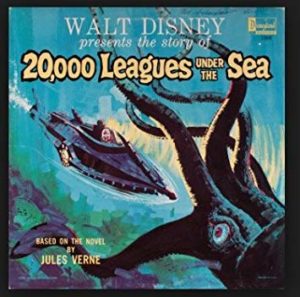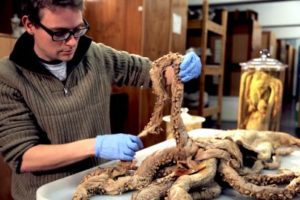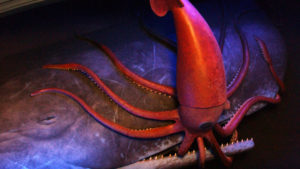The Giant Squid Genome Holds Surprises
I’ve been thinking about invertebrates often lately, and so was delighted to learn that the genome of the giant squid has been sequenced. I’ll never tire of reading new genome papers.
One of the largest animals known, the giant squid is also one of the most elusive, appearing to us mainly as body parts sporting telltale suckers that have washed ashore. A full grown giant squid can’t be comfortably stuffed into an aquarium tank. So most of us know about it from fiction.
Giant Squid in Culture
 The giant sea monster of Scandinavian folklore, the Kraken, terrified sailors in vessels along the coastal waters of Norway and Greenland. It was likely a giant squid, as was Homer’s tentacled Scylla in The Odyssey. Jules Verne’s 20,000 Leagues Under the Sea, written in 1869, famously featured the animal.
The giant sea monster of Scandinavian folklore, the Kraken, terrified sailors in vessels along the coastal waters of Norway and Greenland. It was likely a giant squid, as was Homer’s tentacled Scylla in The Odyssey. Jules Verne’s 20,000 Leagues Under the Sea, written in 1869, famously featured the animal.
More recently, the 2005 film The Squid and the Whale evokes the image of a giant squid battling a sperm whale depicted in a mesmerizing diorama at the American Museum of Natural History. Director Noah Baumbach borrowed the image as a metaphor for the battling parents of his young protagonists.
True squid stories are intriguing too.
The first description came from Captain Peter M’Quhae of the HMS Daedalus. On an August afternoon in 1848, the ship was sailing between the Cape of Good Hope and the island of St. Helena off the coast of Africa, when a huge sea serpent arose from the depths. Many men witnessed the event, and their tales made their way into the newspapers.
The beast, according to captain and crew, was 60 feet long and had gotten quite close to the ship. The captain sketched it, and newspaper readers offered a variety of explanations. Had the sailors seen a dinosaur, an uncommonly long eel, a giant seal, or a gargantuan snake that had lost its way?
In 1857, Japetus Steenstrup, a zoologist at the University of Copenhagen, assembled eclectic clues to the giant’s identity: the smaller squid relatives that people ate, tentacled slimy things washing ashore, a marooned mysterious giant beak, and sailors’ supposedly tall tales.
In another realm entirely, giant squid axons are famous in the annals of neurology because their gargantuan axons – 0.5 to 1.5 millimeters in diameter and almost a meter long – are big enough to see, and great for experiments on nerve conduction. But “giant” in descriptions typically modifies the axon, not the species of squid.
Anatomy of a Giant
The scientific name of the giant squid is Architeuthis dux. It is a cephalopod mollusk.
“Cephalopod” means “head and foot,” and that’s a pretty good description. The foot of the squid is the counterpart to that of a snail, but elaborated into arms and tentacles. The animal has a prominent head. The roughly 800 species of cephalopods include cuttlefishes, octopuses, and squids, and a few nautiluses. Most are soft and squishy.
 Squids have large, complex brains and behaviors, and they can think, but as invertebrates, have no backbones. They live deep in oceans except for the high Arctic and Antarctic waters. Squids grow fast, die soon, and many species eat them. They’re a good source of protein, but I don’t like tentacles in my salads.
Squids have large, complex brains and behaviors, and they can think, but as invertebrates, have no backbones. They live deep in oceans except for the high Arctic and Antarctic waters. Squids grow fast, die soon, and many species eat them. They’re a good source of protein, but I don’t like tentacles in my salads.
Different species range in size. Pygmy squids are a little under an inch long, giant squids average 42 feet long, and the massive 1100-pound colossal squid Mesonychoteuthis hamiltoni is a few feet longer than it’s giant relative.
A squid has eight arms plus two tentacles that it uses to grab prey. The head zooms out of a muscular cone, called the mantle, which contracts to propel the beast. Beneath the mantle lies a hard layer, called a “pen,” where muscles attach. A beak – the thing that washes ashore or that winds up in the belly of a whale – lies at the center of a ring from which the arms, tipped with suckers, emanate. The animal uses the ring to cut up whatever unfortunate animal winds up in the tentacles, like a salami slicer.
One of the most striking characteristics of the squids is that they are changelings, able to quickly alter the color, texture, pattern, and brightness of their skin. The animals use these disguises to communicate, and in camouflage and mimicry. Hiding in plain sight, they can effectively hunt while avoiding being eaten.
A Little Help from Cephalopod Relatives
Getting enough remains of fresh giant squids to probe their DNA is tough, but researchers have determined from analyzing mitochondrial DNA that giant squid are all the same species. But that’s just a handful of genes. Many copies of a full genome are needed to overlap them sufficiently to derive a complete genome. Otherwise, gaps remain.
Museum samples generally don’t work – between decay and preservatives, the DNA is hard to extract and keep intact. Fortunately, fishermen aboard a ship near New Zealand were able to send a freshly frozen tissue sample from a giant squid to the multinational research team, who went to work on the genome. “These new results may unlock several pending evolutionary questions regarding this mantled species,” said lead investigator Rute da Fonseca from the Center for Macroecology, Evolution and Climate at the Globe Institute of the University of Copenhagen. The report appears in GigaScience.
Alas, many of the squid genes were shattered. So the researchers turned to analyzing messenger RNAs (mRNAs) and proteins from easier-to-handle relatives. A genome is like a hard copy, an instruction manual present in every cell. In contrast, collections of RNAs and proteins differ in different cell types, painting portraits of a living organism’s functions.
 But RNA is more delicate than DNA and wouldn’t persist in a lump of rotting squid flesh. So the researchers collected mRNAs from relatives: the common clubhook squid, the Humboldt squid, and the purpleback flying squid, sampling from brains, livers, and sexual organs. They also collected proteins from the muscular mantles of museum specimens of the California two-spot octopus, the Pacific oyster, and the giant owl limpet.
But RNA is more delicate than DNA and wouldn’t persist in a lump of rotting squid flesh. So the researchers collected mRNAs from relatives: the common clubhook squid, the Humboldt squid, and the purpleback flying squid, sampling from brains, livers, and sexual organs. They also collected proteins from the muscular mantles of museum specimens of the California two-spot octopus, the Pacific oyster, and the giant owl limpet.
Matching the RNAs and inferring DNA sequences from the proteins’ amino acid sequences, the researchers were able to flesh out the genome of the giant squid.
Protein Families
The giant squid’s genome includes 33,406 protein-encoding genes splayed across 2.7 billion DNA bases, compared to our 20,000 or so genes in a 3.2 billion base genome. About half of its genome is repeated sequences, most of which can jump around, but that’s not surprising. The genomes of corn, insects, and humans are also half or more repeats, with jumping genes too. These sequences, perhaps raw material for evolution, account for much of the variation in genome size among species. Size doesn’t really matter.
The genome of the giant squid also resembles those of other animals in that it includes gene families, groups of genes with related functions. It harbors the dozen WNT genes found in all mollusks. This gene family encodes secreted glycoprotein growth factors that take part in the cell-cell signaling that controls cell proliferation in early development and later in maintaining tissues. Humans have 19 WNT genes.
Genes encoding proteins called protocadherins are “massively expanded” among the cephalopods. They oversee cell-cell adhesion, essential to the functioning of a nervous system. Like the WNT growth factors, the protocadherins are in vertebrate genomes too. They’re clustered, which suggests that they evolved from an ancient gene that repeatedly duplicated.
Other invertebrates and vertebrates have arrays of WNT and protocadherin genes. In contract, reflectins are specific to cephalopods, discovered in the Hawaiian bobtail squid. These proteins form flat structures that reflect ambient light, providing the trademark glow that a squid uses to blend in and communicate. In squids as well as octopuses, nine reflectin genes cluster on a chromosome.
RNA Editing and An Exploded Homeotic Gene Cluster
Two characteristics of the giant squid genome have broader implications.

Anders Drud and Frederik Wolff Teglhus, University of Copenhagen, Denmark
The giant beast appears to be expert at editing its RNA. This skill enables the animals’ genomes to knit variations on proteins, particularly those involved in nervous system functioning.
At tens of thousands of places in the genome, the RNA-edited regions lie within “highly conserved” DNA sequences, which means that they’re identical, or nearly so, in many species. That is, natural selection has retained them over deep time because they do something essential to successful reproduction.
At the risk of sounding anthropomorphic, this genome organization sets up an intriguing strategy: the conserved sequences keep things stable under the force of positive natural selection, yet at the same time, RNA editing provides a flexibility that benefits establishment of neuron configurations, connections, and excitability. The genome organization is like trying out something new while keeping the old, a common theme in evolution.
The other intriguing characteristic of the giant squid genome is the dispersion of its homeotic (Hox) genes. These genes control where body parts form in relation to each other, from flowers to flies to fungi to the more complex single-celled organisms.
A homeotic mutation mixes up body parts, and they’re behind some diseases of humans. I did my PhD work on the Antennapedia complex of homeotic genes in flies (see next week’s post), specifically mutations that put legs on their heads and antennae on their mouths. The homeobox – the 180-base-pair stretch within homeobox genes that controls the body “plan” – was discovered soon after I got my degree, in my lab (that of Thomas Kaufman at Indiana University). I’m a homeogirl.
The most amazing thing about the homeotic genes is that they are arrayed on a chromosome, in the genomes of all these diverse species, in the exact order in which they are deployed in development, like basketball players waiting on a bench at a game.

But that’s not the case in the giant squid genome. Instead, their homeotic genes are dispersed among chromosomes. Could this be why the body is so huge and blobby, seemingly lacking the nuances of a face, the intricacy of a flower, even the feathery filaments of a mushroom?
“Gain and loss of Hox genes has been attributed to fundamental changes in animal body plans,“ the researchers write. And loss of a major Hox gene in spider mites reduces the number of segments. So did some long-ago mutational event in the giant squid or an extinct ancestor explode the arrayed homeobox genes to new genomic addresses, while retaining enough function to form a body?
The Giant Squid’s Place in the World
It’s hard to tell whether a population that we can’t really observe is threatened, but the researchers point out that oceanic warming and acidification, pollution including mercury and flame retardants, depleted oxygen, and fishing are all threats to the giant squid, as they are to many other species.
“Consequently, there is an urgent need for greater biological understanding of these important, but rarely encountered animals, in order to aid conservation efforts and ensure their continued existence. With the release of this annotated giant squid genome, we set the stage for future research into the enigmas that enshroud this awe-inspiring creature, the species that has inspired generations to tell tales of the fabled Kraken,” the researchers conclude.
(Opening image of giant squid sucker rings credit: The Trustees of the Natural History Museum, London)
